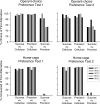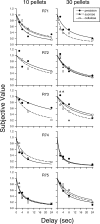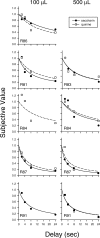Delay discounting of qualitatively different reinforcers in rats
- PMID: 20885809
- PMCID: PMC2831657
- DOI: 10.1901/jeab.2010.93-171
Delay discounting of qualitatively different reinforcers in rats
Abstract
Humans discount larger delayed rewards less steeply than smaller rewards, whereas no such magnitude effect has been observed in rats (and pigeons). It remains possible that rats' discounting is sensitive to differences in the quality of the delayed reinforcer even though it is not sensitive to amount. To evaluate this possibility, Experiment 1 examined discounting of qualitatively different food reinforcers: highly preferred versus nonpreferred food pellets. Similarly, Experiment 2 examined discounting of highly preferred versus nonpreferred liquid reinforcers. In both experiments, an adjusting-amount procedure was used to determine the amount of immediate reinforcer that was judged to be of equal subjective value to the delayed reinforcer. The amount and quality of the delayed reinforcer were varied across conditions. Discounting was well described by a hyperbolic function, but no systematic effects of the quantity or the quality of the delayed reinforcer were observed.
Keywords: behavioral economics; choice; delay discounting; lever press, rat; magnitude effect; reinforcer amount; reinforcer quality.
Figures






References
-
- Baker F, Johnson M.W, Bickel W.K. Delay discounting in current and never-before cigarette smokers: Similarities and differences across commodity, sign, and magnitude. Journal of Abnormal Psychology. 2003;112:382–392. - PubMed
-
- Chapman G.B. Temporal discounting and utility for health and money. Journal of Experimental Psychology: Learning, Memory, and Cognition. 1996;22:771–791. - PubMed
-
- Estle S.J, Green L, Myerson J, Holt D.D. Discounting of monetary and directly consumable rewards. Psychological Science. 2007;18:58–63. - PubMed
-
- Farrar A.M, Kieres A.K, Hausknecht K.A, de Wit H, Richards J.B. Effects of reinforcer magnitude on an animal model of impulsive behavior. Behavioural Processes. 2003;64:261–271. - PubMed
Publication types
MeSH terms
Grants and funding
LinkOut - more resources
Full Text Sources

